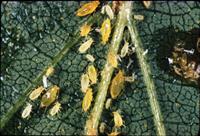|
|
|
|
|

Caption: Aphids
Photo by: E. Klostermeyer
|
|
Aphids
(revision date: 5/4/2022)
Use Integrated Pest Management (IPM) for successful pest management.
Biology
Aphids are small (1/16" to 1/8"), soft-bodied, sap-sucking insects. Depending on species, their color can vary from green to yellowish to rose-colored or black. Some species may appear powdery or woolly. Adults are winged, but usually most of the infestation consists of wingless individuals. Aphids are often found near the tips of shoots, preferring tender new growth where they may cluster in large groups. They also feed on the underside of leaves and on stems. Heavy aphid infestations can cause wilting and yellowing. New growth may be deformed and stunted. Aphids often produce large amounts of honeydew, a shiny, sticky substance which may accumulate on lower leaves or surfaces below infested plants. Black sooty mold will sometimes grow on the honeydew. While the mold will not harm the plant, it is unsightly and may become a problem on household surfaces. Aphids may be brought into the house on plants or may enter through open windows. They can spread from plant to plant by crawling or flying.
|
|
|
Management Options
Non-Chemical Management
- When moving plants indoors that have been outside, they should be quarantined (for example, in a spare bedroom) and kept isolated from other indoor plants for about a month. During this time, regularly inspect the quarantined plants for pest problems. Treat pest problems as necessary and continue isolation until the plants are pest-free for at least one month before integrating them with the rest of your plant collection.
- Quarantine and monitor newly purchased plants or infested plants.
- Heavily infested plants may be too damaged to save. Get rid of them!
- Prune or remove heavily infested leaves and shoots.
- Aphids may be crushed with fingers or wiped off plant stems and leaves. Wiping the aphids with cotton swabs or balls moistened in rubbing alcohol may provide adequate control for light infestations. Excessive alcohol use may harm some plants. If you are concerned, test on a single leaf and wait a few days to check for damage.
- Wash plants in the shower or sink with lukewarm water to remove aphids, honeydew, and sooty mold. Aphids tend to drop off the plant when disturbed, only to climb up again later, so washing will need to be repeated regularly to be effective. Pay particular attention to the undersides of leaves. A plastic bag may be wrapped around the pot and soil to keep soil from spilling out and clogging the drain.
- Wipe or wash sooty mold off leaf surfaces with lukewarm water. Clean other household surfaces with a damp cloth or appropriate cleaner.
- Do not overfertilize. Aphids thrive on lush new growth. Consider switching to a lower-nitrogen fertilizer or a slow-release product.
Select non-chemical management options as your first choice!
Chemical Management
Chemical controls are NOT RECOMMENDED on edible plants (i.e. herbs, salad greens, etc.) grown indoors for culinary use. When practical, take houseplants outdoors to a shaded location before applying chemical controls. Allow sprays to dry thoroughly before returning plants indoors.
If you choose to use a pesticide, some examples of products that are legal in Washington are listed below. Some products are labeled for just INDOOR or just OUTDOOR use, or may allow both uses. Be sure to choose a product appropriate for your situation. Always read and follow all label directions. - Bonide Systemic Houseplant Insect Control
Active ingredient: imidacloprid | EPA reg no: 53883-217-4 - Safer Insect Killing Soap II with Seaweed Extract
Active ingredient: potassium salts of fatty acids | EPA reg no: 42697-59 - Safer Brand End All Insect Killer
Active ingredient: neem oil, clarified hydrophobic extract of neem oil, potassium laurate, pyrethrins | EPA reg no: 59913-14 - WHITNEY FARMS INSECTICIDAL SOAP
Active ingredient: POTASSIUM LAURATE | EPA reg no: 67702-21-73327 - This list may not include all products registered for this use.
|
|
Images
+ Show larger images
| |

Caption: Aphids
Photo by: E. Klostermeyer
|
|
|
|
|
